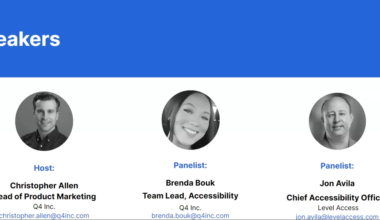May 19, 2022, was Global Accessibility Awareness Day (GAAD), an important day in recognizing the daily digital and technological challenges that people living with disabilities encounter. You might be surprised to hear that one billion people globally and 20-25% of the US population are impacted by accessibility challenges. The webinar, Digital Accessibility in IR: Mitigate Legal Risk with a Proactive Accessibility Partnership, featured Ian Lowe, eSSENTIAL Accessibility Chief Marketing Officer; Alex Wentzell, Q4 Product Marketing Manager; Al Romano, Q4 Web Development Manager; and Jay Vaidya, Q4 Solutions Consultant.
Q4 recently got together with eSSENTIAL Accessibility, our new partner, to host a webinar to discuss the evolution of digital accessibility in IR and its critical importance to public companies. This webinar also informed businesses on how to effectively mitigate legal risk within their IR strategy and expand their audience reach by more than 20%.
Why Now? The Significance of Digital Accessibility in IR
Lowe explains that, in our increasingly digital world, communicating with people with disabilities can be complicated. The challenge for organizations is to make their digital experiences accessible while figuring out how to ensure that they’re not exposed to litigation or regulatory risk. At the same time, the chance to improve the experience of their entire audience and make a material impact in the lives of people with disabilities provides an exhilarating opportunity.
Accessibility has become a prominent topic over the last few years, especially since 2020, due to three main drivers focused on digital accessibility:
- Regulatory environment
- Pandemic impacts
- Competitive landscape
Over the past few years, the change in regulation and litigation has been significant. According to Ian, a consumer successfully used the Americans with Disabilities Act (ADA) to sue a company because its mobile ordering app did not accommodate his needs. Even though ADA was created in the 1990s and therefore doesn’t explicitly mention the digital environment, the US Supreme Court declared that a company can still be sued under the ADA. This case law opened the floodgates to private enforcement, which grants individuals who are unable to get access to goods and services offered by corporations or other organizations on the internet the ability to sue. As a result, the number of lawsuits has been continuously expanding.
Last year, there were over 2,200 digitally-related lawsuits alone, with an additional 250,000 demand letters about digital accessibility. As you can imagine, this has raised the stakes for all organizations, and businesses now realize they have to oblige with the regulations. Ian notes that this phenomenon is not isolated to the United States, referencing Canada’s AOD legislation and Europe’s 301549, stating the amount of legislation in many parts of the world is forcing organizations to be proactive with compliance.
The global pandemic has created urgency around digital accessibility in IR as well. Due to the massive waves of physical location closures across the world, the digital channel went from one of many channels to the only one in which organizations could communicate with their audiences. Ensuring accessibility to ensure a person with disabilities did not encounter barriers or could not access an organization’s goods and services online suddenly became the only option. At the same time, we saw a rise in awareness and brand commitment around diversity, equity and inclusion (DEI) and environmental, social and governance (ESG). Together, these causes have raised the standards for how organizations engage with people with disabilities.
The third driver is the competitive landscape. This last driver represents how the best brands adopt accessibility in DEI initiatives, not just in terms of their customers, but also in terms of their internal talent. In fact, the inclusion of DEI accessibility and talent strategies also allows them to differentiate and maintain their brand presence. If your organization is committed to diversity, equity and inclusion, it’s essential to recognize that the 20 to 25% of people who self-identify as having a disability cut across every other demographic sector in your workforce and customer base. So if you’re committed to DEI initiatives, it’s essential to consider how people with disabilities factor into that calculation.
Stay tuned for the next post in our Accessibility series, “Understanding the ADA in the Online Environment.”


